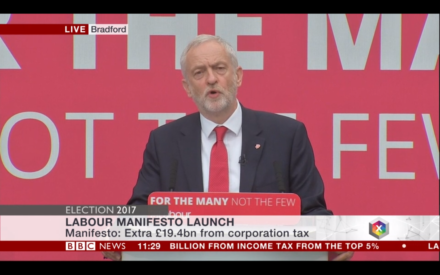
Jeremy Corbyn today pledges a series of tax rises for top earners as well as a new levy on the businesses presiding over the biggest handouts as he wages war on “excessive” pay.
Corbyn put the increased taxes for people earning more than £80,000 at the centre of his manifesto launch in Bradford today. as he pledged not to raise rates for all but the top five per cent.
He also commits Labour to a new levy on the big corporations who pay above £330,000 and revealed plans to nationalise the water industry.
The sweeping reforms to income tax would see the rate raised to 45p for people earning more than £80,000 and 50p for those paid above £123,000. The measure would raise £6.4bn.
And, in a bold move to tackle out-of-control pay, Labour would introduce a new 2.5 per cent levy on firms which pay above £330,000 and a five per cent rate on those offering salaries above £500,000.
“We are asking the better-off and the big corporations to pay a little bit more – and, of course, to stop dodging their tax obligations in the first place,” Corbyn said.
“And in the longer term we look to a faster rate of growth, driven by increased private and public investment, to keep our accounts in shape.
“This is a programme of hope. The Tory campaign, by contrast, is built on one word: Fear.”
Labour also continued the pattern of the big parties at recent elections but pledging not to increase VAT or national insurance as well as holding income tax at current rates “all but the richest 5 per cent of high earners”.
Corbyn was cheered as he addressed a crowd of activists and journalists in Bradford.
He promised a programme that was both “radical and responsible” as Labour sought to fend off accusations of profligacy by publishing a special costings document, named Funding Britain’s Future, with a foreword by John McDonnell, the shadow chancellor.




More from LabourList
GMB union to hold general secretary election next May
Which Labour MPs voted for and against Lib Dem customs union bill?
‘Why I ‘stand with her’: a survivor’s call to unite against violence and misogyny’